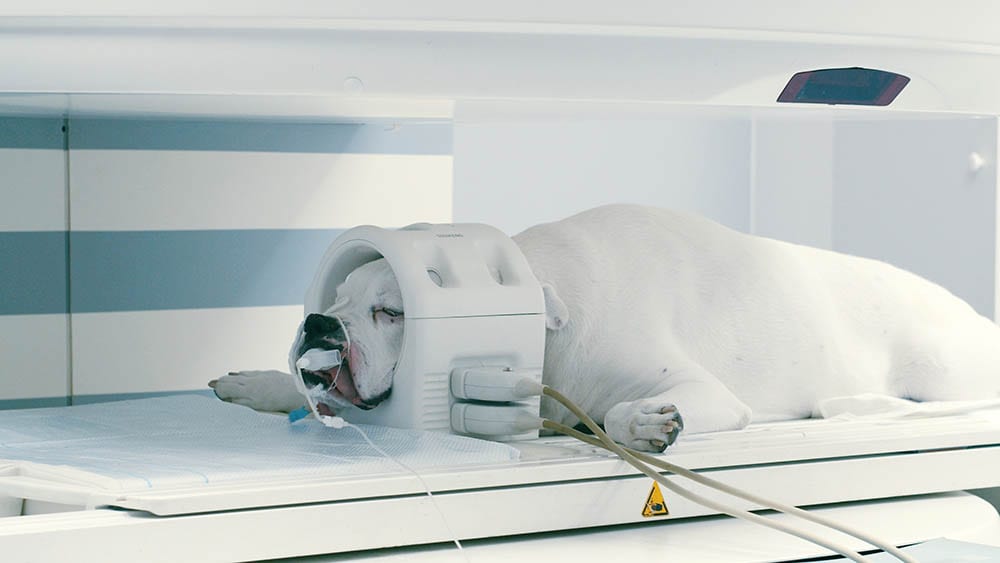Ataxia in Dogs: Causes, Signs, and Treatment (Vet Answer)

Updated on

Click to Skip Ahead
Ataxia is a common symptom of medical problems in dogs, and a good one to be able to spot at home. Ataxia is the scientific word for a dog becoming wobbly and losing balance when moving – a bit like someone who is drunk. If a dog is unstable in this way, they are labeled “ataxic.” They might be poorly coordinated, falling from side to side, circling, and struggling to move in a normal, comfortable way.
Ataxia often affects all four legs of a dog, as well as the head and body, but it is possible for a dog to be normal at the front, but ataxic only in the back legs. It can be as subtle as a change in the way your dog moves their feet during walking, or as obvious as a dog struggling to stand up at all. The main thing is to be aware of what is normal for your dog so that if anything becomes abnormal, you will spot it quickly. But what causes ataxia, and what can we do about it?
How Does Ataxia Happen in Dogs?
Broadly, ataxia happens when the nerves and nervous system are not functioning as they should, and so the normal messages that pass around the body are not carried or are carried poorly. This can happen in two ways:
- The coordination and balance centers of the brain are not functioning correctly or are unable to pass on the right messages to the right part of the body. The right messages are not being delivered to the body.
- The brain is working normally but is not receiving information about where the body is and what it is doing, so it cannot accurately plan its next move. The right messages are not being delivered to the brain.
It is important to separate ataxia from other conditions such as limping, weakness, or lethargy. In these situations, the nerves are still working correctly, but there might be other issues at work. Ataxia is a nerve or neurological condition, whereas lameness for example is more likely to be orthopedic (bone or connective tissue) in origin.
Ataxia may present as a symptom by itself. But it is often accompanied by other symptoms, such as a head tilt, dizziness, lethargy, vomiting, and incontinence.

What Causes Ataxia in Dogs?
There are many possible causes of ataxia in dogs. For this reason, it is always recommended that you arrange for your local veterinarian to examine your dog if you think they are ataxic. Ataxia needs to be put in context with any other symptoms and your dog’s medical history to get an accurate diagnosis at the earliest possible stage.
Ataxia can be split into three possible origins:
1. Vestibular ataxia
Where the balance centers of the brain, including the inner ear, are working poorly and the right messages are not delivered to the body. Significant causes might include:
- Inner ear infections
- Brain lesions such as tumors, inflammation, or stroke (blood clots)
- Toxins or poisons, such as antifreeze (ethylene glycol), illegal drugs (marijuana and mushrooms, for example), xylitol (artificial sweetener), and slug pellets (metaldehyde)
2. Proprioceptive or Sensory Ataxia
Where the proprioceptive nerves that relay information to the brain about where the body and legs are stops working properly. This means the brain cannot coordinate movements as it doesn’t know where the body is starting or finishing – the right messages are not being delivered to the brain. Causes might include:
- Toxins, poisons, and drugs, such as those already listed above. The classic example, mostly in humans but occasionally in dogs, is alcohol, which slows nerve conduction, making us drunk and therefore ataxic. Dogs can be drunk too, which is why alcohol is not recommended for our pets! Other commonly prescribed drugs such as opiates, phenobarbitone, and gabapentin can sometimes cause mild ataxia1.
- Diseases of the nervous system itself – any condition that damages the nerves of the brain or spinal cord can cause ataxia
- Brain inflammation (meningitis or encephalitis) or spinal cord inflammation (myelitis)
- Blood clots (strokes or embolism) in the brain or spine
- Trauma to the brain or spine, including slipped discs which press on the nerves and stop messages passing
- Tumors of the brain or spinal cord
- Autoimmune diseases, where the immune system of the body attacks its own nerves by mistake

3. Degenerative damage
Nerves age just as we do and can start to fail through wear and tear. This usually affects the longest nerves of the body first – those found between the brain and back legs. This is often seen in older, larger breed dogs alongside arthritis.
Genetic or developmental diseases:
- Some dogs are born with physical abnormalities of their brain and spinal cord. Examples would be hydrocephalus (excessive fluid within the brain, often seen in Chihuahuas) and syringomyelia (excessive fluid within the spinal cord, often seen in Cavalier Spaniels). These put pressure on the nerves and may stop them from functioning normally
- Some giant breed dogs can be born with an inherent weakness in their spine or their neck, and this can pinch on the spinal cord and cause ataxia. This is known as “wobbler” syndrome
4. Cerebellar Ataxia
Where the part of the brain that is important for coordination (the cerebellum) does not function as it should, and so the right messages are not delivered to the body. Causes include:
- Syringomyelia as mentioned above
- Viral infections of the cerebellum may stop it from developing normally
- Any trauma, inflammation, or tumor of the cerebellum
Ataxia can also be seen where the nerves are healthy, but messages are affected by changes in the body around them, especially changes in blood chemistry and composition.
- Changes in the composition of the blood, for example, due to dehydration or red blood cell numbers (polycythemia or anemia)
- Changes in the blood chemistry, altering the balance of minerals like potassium (kidney disease, or hyperaldosteronism in cats, for example)
- An overactive thyroid can also affect nerve function
- Low blood oxygen levels

What Should I Do if My Dog Has Ataxia?
It is important to contact your local veterinary clinic as soon as possible for advice. Ataxia has many potential causes and to treat them appropriately, an accurate diagnosis is needed from a veterinarian. Your veterinarian will discuss your dog’s history with you to try and take any clues from there. A physical examination will then provide more information. In some cases, further investigations such as blood tests and scans may be necessary, but your veterinary professional will be able to discuss and guide you on these.
In many cases of ataxia, an exact diagnosis is challenging. Given that many places where nerves run (especially in the brain and spinal cord) are hard to access, advanced imaging such as CT or MRI scans may be necessary, and this means that in some cases, treatment may be impossible.
How Is Ataxia Treated in Dogs?
Treatment depends on the exact cause. In some cases, ataxia may not be fully curable, and some symptoms may persist even despite the original problem going away or being well managed. Nerves are not as good as other cells at repairing themselves after damage and so some changes may be permanent. Unfortunately, treatment for the neurological conditions that cause ataxia can be challenging lifelong. Recovery times may be weeks to months, and in some cases, time is the best and only healer.
In mild cases of ataxia after, for example, mild intoxication, treatment may be short-term, supportive, and symptomatic. Depending on how severe the symptoms are, your dog might need intravenous fluids via a drip, anti-nausea medication, and pain relief.
Long-term medical management using anti-inflammatories and antibiotics is indicated in some conditions such as meningitis or inner ear infections.
Ataxia can be a complex issue and really needs the involvement of a veterinary professional to help you and your dog achieve the best outcome as soon as possible.
Conclusion
Ataxia is seen if your dog becomes wobbly or poorly coordinated over the head, body, and legs. It is a complex issue involving problems with the body’s communication system – the nervous system. Where the nervous system does not function properly, dogs may become ataxic. There are many potential causes, including poisons, intoxications, damage to the nerves or brain, or changes in the blood chemistry. There is typically no preventive plan for ataxia other than keeping your dog generally fit and healthy. Ataxia can be a challenge to diagnose, treat and manage. It is vital if you suspect your dog is ataxic that you contact your local veterinary clinic as soon as possible for professional advice.
Featured Image Credit: CameraCraft, Shutterstock












